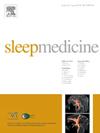共济失调毛细血管扩张的睡眠相关问题和睡眠障碍
IF 3.8
2区 医学
Q1 CLINICAL NEUROLOGY
引用次数: 0
摘要
目的:共济失调毛细血管扩张症(AT)是一种罕见的神经退行性疾病,与睡眠相关的问题可能会出现。我们调查了AT患儿的睡眠相关问题及其临床状况。方法采用《儿童睡眠习惯问卷》和《儿童睡眠障碍量表》对46例AT患者和92例健康对照者进行问卷调查。我们根据患者的临床评分将AT的临床亚组定义为轻度(n = 10)和中/重度(n = 36)。我们比较了两组之间的结果。结果AT患者中位年龄为130.5(104.8 ~ 175.0)个月,HC患者中位年龄为125.5(85.0 ~ 177.0)个月。发生频率(AT组为6.5%,HC组为0%)、睡眠障碍风险(AT组为60%,HC组为25%)和睡眠问题(AT组为80%,HC组为50%)AT组高于HC组。由于我们的研究中AT和HC的男女比例不同,我们应用了进一步的分析,调整了性别和年龄;AT患者出现睡眠障碍的可能性几乎是HC的4.5倍,出现睡眠问题的可能性是HC的6倍。睡眠相关问题随着HC患者年龄的增长而减少;睡眠问题部分减少,但睡眠障碍并没有减少。结论AT患者的睡眠结构、行为和习惯可能受到干扰,即使病史中无症状报告,也有必要在临床随访中纳入睡眠筛查工具。需要进一步的大规模临床研究来开发针对AT和类似神经退行性疾病的睡眠筛查工具。本文章由计算机程序翻译,如有差异,请以英文原文为准。
Sleep-related problems and sleep disorders in ataxia telangiectasia
Objective
Ataxia telangiectasia (AT) is a rare neurodegenerative disorder and sleep-related problems may be expected. We investigated sleep-related problems in children with AT in relation to their clinical status.
Methods
We administered Children's Sleep Habits Questionnaire and Sleep Disturbance Scale for Children to patients with AT (n = 46) and a matched healthy control (HC) (n = 92). We defined clinical subgroups of AT as mild (n = 10) and moderate/severe (n = 36) according to patients' clinical scores. We compared the results between the groups.
Results
The median age was 130.5 (104.8–175.0) months in AT patients and 125.5 (85.0–177.0) months in HC. The frequency (6.5 % in AT, 0 % in HC), risk of sleep disturbance (60 % in AT, 25 % in HC), and sleep problems (80 % in AT, 50 % in HC) were higher in AT than in HC. As the male/female ratio differed between AT and HC in our study, we applied further analyses adjusting for gender and age; AT patients were almost 4.5 times more likely to develop sleep disturbances and 6 times more likely to have sleep problems than HC. Sleep-related problems decreased with increasing age in HC; sleep problems partially decreased in AT, but sleep disturbances did not decrease in AT.
Conclusion
Sleep architecture, behavior, and habits may be disturbed in AT, justifying the inclusion of sleep screening tools in the clinical follow-up of these patients even if no symptoms are reported in the medical history. Further clinical studies in large cohorts are needed to develop sleep screening tools specific to AT and similar neurodegenerative diseases.
求助全文
通过发布文献求助,成功后即可免费获取论文全文。
去求助
来源期刊

Sleep medicine
医学-临床神经学
CiteScore
8.40
自引率
6.20%
发文量
1060
审稿时长
49 days
期刊介绍:
Sleep Medicine aims to be a journal no one involved in clinical sleep medicine can do without.
A journal primarily focussing on the human aspects of sleep, integrating the various disciplines that are involved in sleep medicine: neurology, clinical neurophysiology, internal medicine (particularly pulmonology and cardiology), psychology, psychiatry, sleep technology, pediatrics, neurosurgery, otorhinolaryngology, and dentistry.
The journal publishes the following types of articles: Reviews (also intended as a way to bridge the gap between basic sleep research and clinical relevance); Original Research Articles; Full-length articles; Brief communications; Controversies; Case reports; Letters to the Editor; Journal search and commentaries; Book reviews; Meeting announcements; Listing of relevant organisations plus web sites.
 求助内容:
求助内容: 应助结果提醒方式:
应助结果提醒方式:


